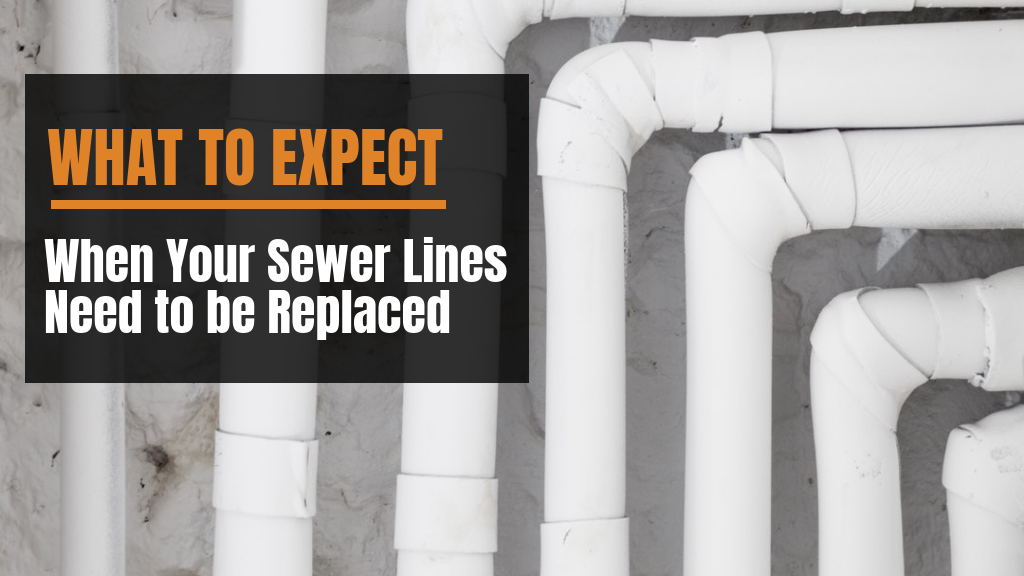Sewer lines are pipes that run from your house to the city sewer or to your septic tank. You may never have to think about these pipes as long as they are working properly. However, when these pipes have clogs, and your wastewater is backing up into your home, they will be all you can think about! These lines need attention periodically to keep them in good working order. Clogs in sewer lines may happen naturally, so how do you know whether the main sewer line needs to be unclogged by a professional or sewer line replacement is required? You will need to call in a Houston plumbing expert to determine where your clog is and how to get rid of it. Most clogs can be fixed by using what is called the “trench method.” This is where the plumber will dig a hole in your yard above the sewer pipe. He will then proceed to fix the clog from there. Things become a bit more complicated if the expert tells you there is a need to replace your sewer lines. There are a few options for the replacement process.
Tunneling Under Your Home
When faced with the need to replace the sewer pipes under a slab-on-grade foundation, the plumber may suggest tunneling under the home. This method is quite dangerous and should be avoided, when possible. Tunneling is just what the name implies. It is a process in which the contractor will dig a tunnel under a commercial or residential building. The contractor will then crawl under the building in order to cut out the old pipes and hang the new ones from the slab foundation.
There are serious safety concerns when tunneling under a home. Collapsing soil is just one of them. There is also a long-term risk for your home due to compromised soil under the foundation. Once dirt has been dug from under your house, there is no guarantee that the remaining soil will support the foundation, regardless of whether or not it is still compacted. If the soil is no longer compacted, there is no way to fit a soil compactor under the slab. So, the initial soil density can no longer be achieved.
Compared to replacing a sewer line under a slab-on-grade foundation, making repairs or replacing pipe sections under a pier and beam foundation, which allows unrestricted access to plumbing, is often easier and less expensive.
Replacing Pipe Sections for Your Houston Home
In projects involving slab-on-grade foundations, replacing one section of the pipe at a time is a better option than tunneling. This process starts with the plumber determining which pipe sections need to be replaced. The easiest way to accomplish this is to run a camera through the pipes, looking for breaks or leaks. Once the plumber locates a damaged portion of the pipe, he will break up the flooring above that section with a sledgehammer. The damaged portion is then cut out and replaced with new piping. This method is time-consuming and costly. Not to mention that you’ll most probably have to cover the cost of repairing your floor and subfloor as well. The process is also very messy, which means that restoring your home to its original state will take both time and money.
Pipelining in Houston
Pipelining, also referred to as relining, is a no-dig solution to replacing or repairing outdated sewer lines. This method uses a flexible PVC pipe, known as a liner. The liner is placed inside the old sewer line. Once inside the pipe, the liner is inflated, which causes it to harden and form a new pipe within the existing one.
The liner is a continuous, smooth pipe without seams or joints. Thus, test results show the same flow capacity despite the liner being a smaller diameter. Compared to the aforementioned sewer line repair methods, liners are installed much faster, with minimum inconvenience and disruption to your property. Not only is there less damage to your property than digging inside or outside to replace pipe sections; but sewer line relining is also less dangerous than tunneling under your home.
This is where you may be asking, “How much does each method cost?” Tunneling requires heavy equipment for digging. There will need to be extra manpower for crawling under the home. Finally, you will need to pay for additional permits from OSHA due to the risk factor involved with this method. This adds up to a costly repair. The cost can be upwards of $10,000. As well, digging into the floor of your home to replace multiple portions of pipe will cost approximately $3,000 to $6,000. This does not include the repair of your flooring after the fix. Although pipelining costs about the same as digging your floor up to replace the lines, you won’t have to deal with all the mess.
The best way to avoid the high cost of pipe repair or replacement is to do regular maintenance on your sewer pipes. Besides keeping your pipes and sewer line in good condition, preventative maintenance can also prevent foundation damage. If you wish to learn more about how to prevent foundation damage, browse through our blog or contact our professionals!




Homeowner’s Comment: Sewer Line Replacement Experience
I find it surprising that you could use sewer line replacement to remove clogs from the line and any form of damage caused by it. I saw an online news article about clogged sewers and I got curious about how they can get fixed. I will consider the idea of seeking a plumber who could do this for my home when I need it.